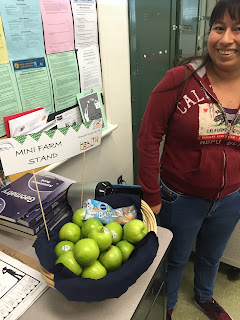 |
| Health Academy 'Legion of Health' team with LAUSD Food Services Director, Laura Benevides. |
The school cafeteria has been the subject of plenty of
derision over the years given such negative perceptions of the food served and limited
resources to meet the demands of a diverse student body. In the
Los AngelesUnified School District (LAUSD), home to 640,000 students in more than 1,187
schools, the subject of school nutrition is a high priority. It is a priority shared
by
National Health Foundation’s innovative “
Health Academy,” a youth-led, community
research and advocacy program.
Since December 2013, teams of students have been researching
and identifying challenges to accessing and consuming healthy
foods and beverages, as well as obstacles for physical activity in their South
Los Angeles community. One of their focus areas has been school nutrition. For
many LAUSD students, the meals they consume at school are their primary meals
of the day, and in some cases, their healthiest meals.
One of the Health Academy’s youth-led
teams, Legion of Health, has been addressing the issue of healthy lunches and
snacks at Jefferson High School and the students have made important headway
since the program’s inception. Last year, students conducted menu sampling in
an effort to introduce tastier and healthier menu options. According to LAUSD
Food Service Director Laura Benavides, some of the new choices would be
available as early as this April. She noted that given the sheer size of the
district, changes take time, but she extended an invitation to the team to
participate in the LAUSD Menu Committee meeting next year where critical
decisions on menu development would be made.
One of the key findings of student
research has been that with only 30 minutes for lunch and the increased wait
times, many students are avoiding the cafeteria and are relying on alternative venues
that promote sugary snacks, such as the student store and vending machines.
Research has also shown that consuming a healthy meal takes more time, time
that most students simply will not take. In an effort to have more students eat
lunch in the cafeteria, the district is taking a serious look at reducing wait
times. The Health Academy students, for their part, took a practical approach
to solving the lunchtime crunch: a cafeteria makeover. By reorganizing the layout
of the cafeteria, they were able to create a more efficient flow of traffic, thereby
reducing wait times. This improvement has helped increase school lunch
participation and the number of students eating at the cafeteria every day.
An LAUSD program called Breakfast in
the Classroom (BIC), implemented in fall 2014, was widely touted as one way to
ensure students were starting their day with a healthy meal and the nutrition needed
to get through the morning. An unintended consequence of the program has been
an increase in food waste. Last year, the Health Academy team tackled the food
waste issue, as well as their limited access to healthy food, by creating the
Health Academy Mini Farm Stand. Students redirected the fresh fruit left over
from the BIC program to individual baskets in several test classrooms. Students
in need of a snack could help themselves to a piece of fruit from the basket in
their classrooms. The results were overwhelmingly positive. Teachers were
pleased, students consumed more fruit, and food waste from BIC was
significantly reduced. The project was expanded school-wide in February of this
year. There are plans to expand the project to more schools in the district,
but the students have set their goals even higher: They are hoping LAUSD will
adopt the concept district-wide!
 |
| The Mini Farm Stand filled with fresh fruit is now a feature in 2 LAUSD schools! |
|
These students have also been
instrumental in addressing access to water in Jefferson High School by working
to install one of the first Hydration Stations in the district. The filtered
water station was unveiled Fall 2015 and is designed for students to refill
their water bottles as opposed to reaching for sugar-sweetened beverages in the
vending machines. Sugar-sweetened beverages alone are responsible for a large
number of unhealthy calories that lead to obesity and the associated health
risks such as diabetes. The Health Academy students championed the Hydration
Station effort after their research revealed that students wanted access to more
fresh water and to consume less sugary drinks.
The Health Academy students have,
through their research, project design, and implementation, created lasting
changes in one of the largest school districts in the nation. Moreover, they
have been exposed to real-world learning that has included meetings with school
officials, community stakeholders, and elected officials, all in an effort to
realize lasting, equitable policy change with respect to the health and
wellbeing of their South Los Angeles community. These young community advocates
have already left a mark on the health of their community, a mark that will
hopefully inspire others to do the same.





